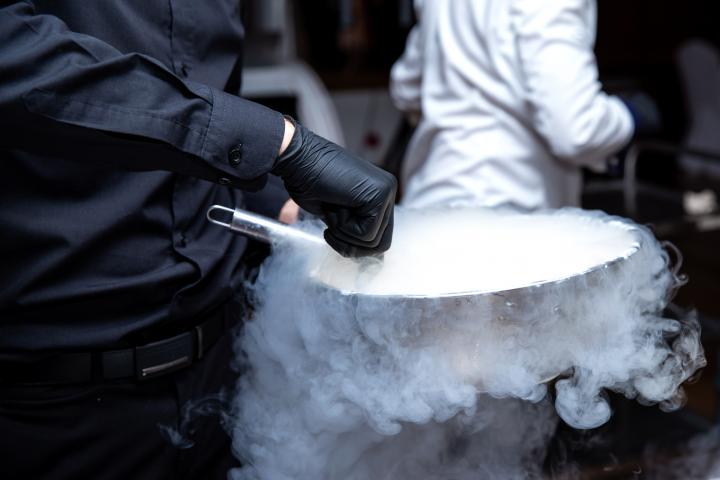NOW YOU’RE COOKING WITH (NITROGEN) GAS!
It’s not the first thing that comes to mind when you mention cooking, yet Nitrogen in either liquid or gas form has been singled out as one of the “trendiest elements” in modern cooking and food preparation.
British celebrity cook Heston Blumenthal helped bring nitrogen cooking techniques into the mainstream through his appearances on “Top Chef” and other popular TV programs. His “nitro-scrambled egg and bacon ice cream” created quite a splash in the culinary world.
Around the same time, American chef Richard Blais, winner of the Bravo Channel’s Top Chef: All-Stars competition, also impressed eating enthusiasts with his use of liquid nitrogen to create innovative treats.

It’s not surprising that nitrogen (in either gas or liquid form) would be used in the food and beverage industry. Nitrogen’s properties are very conducive to food preparation, where creativity and presentation are everything.
Liquid nitrogen is about as cold as you can get in the kitchen, registering a whopping negative 196 degrees Celsius (-321° F). Why does this matter? When foods are frozen in a traditional freezer, they form relatively large ice crystals, which impact the consistency of the product. By comparison, liquid nitrogen forms microscopic ice crystals, which can create frozen foods with an almost unbelievably creamy consistency. As such, liquid nitrogen is commonly used to make gourmet restaurant ice creams, as it provides a more velvety texture than any ice cream machine can.

Beer enthusiasts may have seen nitrogen in action at their local sports bar or pub. Many bartenders serve Guinness beer. Most people might not be aware that a mixture of carbon dioxide (CO2) and nitrogen (N2) is used to create the creamy carbonated texture enjoyed worldwide.The nitrogen/CO2 blend is delivered from a Nitrogen gas tank that contains 75% nitrogen and 25% CO2.
Nitrogen is not just used to prepare food, this inert gas can also be used in food preservation. – Food packaging specialists have found that by replacing food packaging with Nitrogen, the shelf life of products can be extended. Increased nitrogen content preserves freshness, protects the nutrients, and prevents aerobic microbial growth.
There’s no question about the benefits of Nitrogen use in food preparation, storage and delivery. The one critical factor to remember in all aspects of use of this gas is safety and proper environmental monitoring. Earlier this year, six people died at a US food processing facility in Georgia. The cause of the tragedy was determined to be a fatal nitrogen leak.
When warmed up, liquid nitrogen vaporizes and expands, producing a large cloud of nitrogen gas that can displace oxygen in poorly ventilated rooms.
This can lead to headaches, dizziness, loss of consciousness, disorientation, and death by asphyxiation, according to Utah State University. And because the gas is odorless, colorless, and inert, there are often no warning signs that indicate a leak has occurred. Many succumb to their symptoms before they realize what is happening.
Although it is not toxic, nitrogen is an inert gas, a leak of Nitrogen can displace oxygen in the atmosphere. The atmosphere normally consists of 21% oxygen – a drop to 15% is enough to cause oxygen deprivation (hypoxia) in the body, and a drop to 8% is enough to cause unconsciousness and death.
It’s not just nitrogen gas that can cause problems. A small amount of liquid nitrogen will turn into a large amount of nitrogen gas – expanding up to 700 times.
When using nitrogen, either in gas or liquid form, it is important not to use it in a confined space, ensure it is stored safely and to have adequate ventilation. Using an atmospheric monitor to detect levels of oxygen in the atmosphere is essential – the Analox Group offers a complete range of fixed and portable O2 gas detectors for all industries and price ranges. Among the popular options is the AX60+ which is currently keeping the hospitality industry, popular eating establishments and local bars and pubs safe throughout the world.
